Alan Pascal was born in 1924, Wokingham, Surrey, the son of Henry Philip and Ada Pascal (nee Croxford) of Earley, Reading, Berkshire. He was granted an emergency commission in the Reconnaissance Corps, as a Second Lieutenant, on the 13 February 1944.
He was posted to the 1st Airborne Reconnaissance Squadron in February and assigned as the commander of 12 Section, ‘D’ Troop.
He was on parachute course 109, at RAF Ringway, 24 March to 9 April 1944. This was the first main Recce Squadron course of four Officers and 40 Other Ranks. Lieutenant Pascal’s parachute instructors comments: ‘Very good performer. Good leader. Confident.’ [1]
He flew to Arnhem on Sunday, 17 September 1944, from the aerodrome at Barkston Heath and parachuted onto DZ ‘X’ near Heelsum in Holland as part of ‘Operation Market-Garden’.
‘D’ Troop were at the rear of the Squadron for the attempted coup-de-main on Arnhem Bridge, so when they ran into the German blocking position just to the East of Wolfheze railway station, they attempted to see if they could get around it to the North, on foot, which failed.
The next day the Squadron, minus ‘C’ Troop, attempted to advance into Arnhem along the main road, the Utrechtseweg, through Oosterbeek, but were stopped by another German blocking position near the Mariendaal area. Dismounted action was called for and casualties were suffered by the Squadron, one of them in ‘D’ Troop.
‘Shortly afterwards, Trooper George Adams became the second casualty of the morning. Adams was standing beside his Section officer, Lieutenant Alan Pascal, just a few feet from their stationary vehicles. They were on Utrechtseweg at the time, and he remembers how both of them were using the large beech trees as cover from enemy fire. As he sheltered from what appeared to be the probable location of the enemy, Adams recollects that he looked over a low wall into a garden, where conifers and rhododendrons were interspersed with more of the beech trees. The house itself, a large imposing red brick building called De Vergarde was set well back from the road, but parked outside the front door was an ambulance. He recalls that the ambulance attendants were dressed in civilian clothes, but standing beside the vehicle was a group of armed German soldiers. “It looked to me,” says Adams, “as if they were about to get into the ambulance and head off somewhere, so I told Mr Pascal what I thought was happening. He didn't waste any time at all in making up his mind what to do. ‘Open fire!’ he snapped out, which we did. Just what happened then I don’t really know, because as we opened up, so did someone from the houses on the other side of the road, and almost right away I got a bullet in the arm. What I do remember is that just then the ambulance drove out very fast through the gate of the big house and headed off in the direction of Arnhem. By that time, there were no German soldiers in sight at the front of it.”’ [2]
It is likely, however, that the Germans were picking up some of the British wounded that had been left there from a battle earlier that morning, and taking them to the St. Elizabeth’s Hospital.
By Wednesday, 20 September, the Recce Squadron were in defensive position in the northern suburbs of Oosterbeek, with ‘D’ Troop in the area of Steijnweg, between the junctions with Paul Krugerstraat and the more northerly Bothaweg. By Saturday, 23 September the situation was becoming critical for this small band of defenders.
‘With a record of mounting success in blasting the British out of their positions on Steijnweg, it was virtually certain that the Germans would keep up the pressure and, perhaps, mount yet another attack before nightfall. It came in at 16.00 hours, this time from both east and west, and two more casualties were immediately sustained due to shelling. Park's men held for half an hour, before eventually withdrawing about 150 yards south to a house at the junction of Steijnweg and Transvaalstraat. This one had escaped damage, but the growth in activity of the German self-propelled guns had demonstrated that the house itself would be vulnerable. Recognizing this, Captain Park ordered his men to dig in in the garden, but in view of the growing seriousness of his position decided also to seek advice as to future strategy. As a result, Lieutenant Alan Pascal volunteered to return to Squadron HQ to report on the situation.
‘It was after dark when Pascal arrived at Allsop’s position on Oranjeweg. Geoff Costeloe, who was present at the time, still remembers how Alan Pascal conveyed Park’s message that, with the Germans right on his doorstep and his own level of casualties extremely high, he had considerable misgivings about the ability of ‘D’ Troop to hold any longer. Clearly, the infiltration of the perimeter area at that point was becoming more serious all the time, and there was every indication that the Hartenstein could very well, itself, soon become the most northerly-held position. Having listened to the report, David Allsop felt it right that General Urquhart should be informed, and Costeloe was asked to escort Pascal across to Divisional HQ. “I remember,” says Costeloe, “how desperately tired Urquhart looked, but how patiently he listened as we explained the situation. He didn’t interrupt at all, but when we’d finished, he turned to Pascal and said, ‘I’m very sorry, my boy, but I’m afraid you must go back and hold.” The remnants of ‘D’ Troop were also requested to try if possible to retake their former position, and, as they returned to the Squadron lines, neither the adjutant nor the young subaltern had any illusions about what the outcome would probably be. Like all the others who had fought and endured, Alan Pascal would continue to find the stoicism and the courage to go on, but Geoff Costeloe has never forgotten the look of distress that was registered upon his face as he set out to rejoin his Troop. Costeloe never saw him again.
On his return, Pascal found that the dwindling group of weary survivors had taken another heavy mortar attack during his absence and there had been two further casualties.’ [2]
Lieut Pascal was killed in action on Sunday, 24 September 1944, during yet another attack by the Germans upon ‘D’ Troop’s positions.
‘The attack was responsible for finishing off ‘D’ Troop. The prelude was a terrifying mortar bombardment on their positions, of an intensity not previously felt, and James Pyper still remembers the succession of events that brought the long drawn-out agony to a horrific end. “During the afternoon,” he recalls, “we were dug in in the garden of a house. My own trench was right beside a stone wall, and Captain Park and two others were in the next trench along. Following the first mortaring, there was an exchange of shooting, and it was then that Captain Park said, ‘I'll change places with you, Sergeant.’ Three times after that we beat them off, until later in the afternoon came an extra fierce mortar barrage. I remember at one point, shouting ‘Down!’, and when the smoke cleared, we found Captain Park, Lieutenant Pascal and Trooper Walker all still standing upright in the trench by the wall, but with their heads blown off.” The bombardment was then followed by the inevitable infantry attack, which closed in in strength, and those who were left fought until their ammunition ran out.’ [2]
He was initially buried at the corner of Ornajeweg and Bothaweg, but now lies at rest in the Arnhem/Oosterbeek War Cemetery, 3. D. 1. His profile photo was taken at his passing Out Parade in February 1944.
NOTES:
[1] Parachute Course Report, RAF Ringway. April 1944.
[2] ‘Remember Arnhem’, by John Fairley.
Researched and written by R Hilton.
Read More

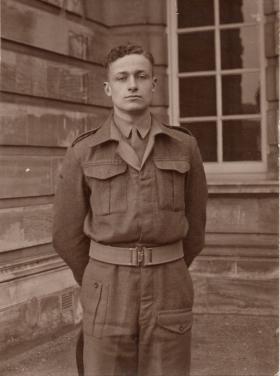
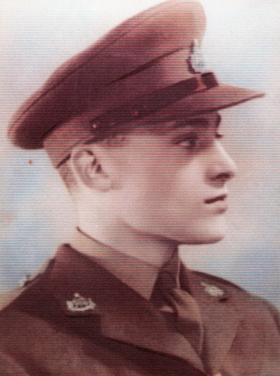
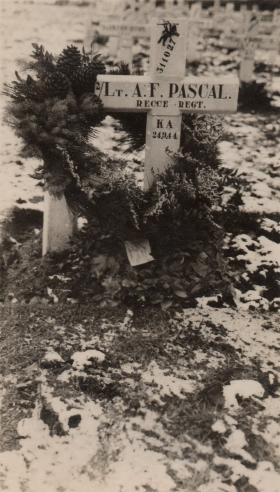
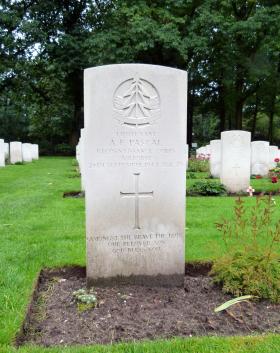
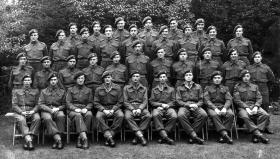
Latest Comments
There are currently no comments for this content.
Add Comment
In order to add comments you must be registered with ParaData.
If you are currently a ParaData member please login.
If you are not currently a ParaData member but wish to get involved please register.